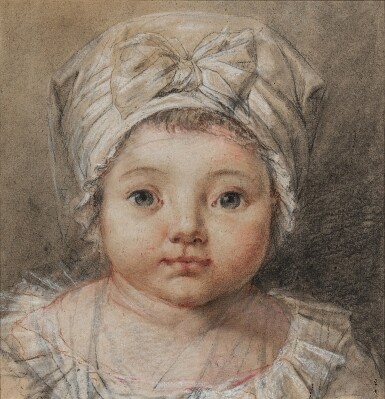
Élisabeth Louise Vigée Le Brun
Portrait of a Little Girl
Auction Closed
January 31, 03:58 PM GMT
Estimate
30,000 - 40,000 USD
Lot Details
Description
Élisabeth Louise Vigée Le Brun
Paris 1755 - 1842
Portrait of a Little Girl
black, red and blue chalk, heightened with white chalk and stumping
9 ⅞ by 9 ⅝ in.; 249 by 247 mm (sight size)
Jean-Luc Ryaux, Paris, by 2002,
where acquired by the present owner
Élisabeth Louise Vigée Le Brun, Souvenirs 1755-1842, Bibliothèque des correspondances, mémoires et journaux, text by Geneviève Haroche-Bouzinac, Paris, Honoré Champion, Paris 2008, pp. 432 and 433, reproduced.
The young girl depicted here, head and shoulders and looking out at the viewer, has not been identified. Her blue eyes are wide and her cheeks plump and flushed; she is dressed in a white frilly garment, only the collar of which is visible, and she wears a bonnet adorned with a bow. As in the portrait of the sleeping baby (lot 29), Madame Le Brun has built her image with chalks of three colors: red, black and white – the time-honoured trois crayons technique so beloved of French artists, especially in the eighteenth century, with the addition of blue pastel for the eyes of the child. The textures are tangible, the lines of chalk used to create ruffles and pleats in the little girl’s clothing and bonnet. Accents in red chalk highlight her cheeks and mouth and also define the areas around her shoulders. The combination of strokes and rapidity of placement suggest a playfulness that is echoed in the slight smile gracing the child’s lips.
This wide-eyed innocence of youth is also to be found in a 1787 portrait, painted in oils by Mme Le Brun, depicting her own daughter, Julie.1 The painting is an almost full-length portrait, in profile, of Julie holding a mirror. The young girl’s face is only fully revealed in the reflection: her bright, inquisitive eyes, the roundness of her face and her pursed plump lips. It is a very beautiful and intimate portrait that reveals as much about the tenderness of motherhood as it does about the innocence of childhood. Madame Vigée excelled in capturing the unassuming and carefree nature of childhood in her studies of young children, both those of aristocratic families and her own.
A pastel portrait, of a slightly younger child, head and shoulders, executed circa 1782-85, is in the Royal Collection and yet another is in the Nationalmuseum, Stockholm.2
1. J. Baillio, Élisabeth Louise Vigée Le Brun 1755-1842, exh. cat., Fort Worth 1982, p. 74, cat. 25
2. J. Baillio and X. Salmon, Élisabeth Louise Vigée Le Brun, exh. cat., Paris 2015, p. 192, fig. 1
You May Also Like










